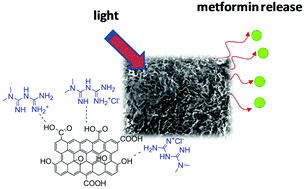Near-infrared light activatable hydrogels for metformin delivery
Abstract
Drug loaded hydrogels have proven to be versatile controlled-release systems. We report here on heat active hydrogel formation by mixing graphene oxide (GO) or carboxyl enriched reduced graphene oxide (rGO-COOH) with metformin hydrochloride, an insulin sensitizer drug currently used as the first line therapy to treat patients with type 2 diabetes. The driving forces of the gelation process between the graphene-based nanomaterial and metformin are hydrogen bonding and electrostatic interactions, weakened at elevated temperature. Using the excellent photothermal properties of the graphene matrixes, we demonstrate that these supramolecular drug reservoirs can be photothermally activated for transdermal metformin delivery. A sustained delivery of metformin was achieved using a laser power of 1 W cm−2. In vitro assessment of the key target Glucose-6 Phosphatase (G6P) gene expression using a human hepatocyte model confirmed that metformin activity was unaffected by photothermal activation. In vivo, metformin was detected in mice plasma at 1 h post-activation of the metformin loaded rGO-COOH gel.

- This article is part of the themed collection: Nanocarbons


 Please wait while we load your content...
Please wait while we load your content...